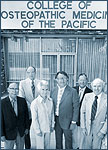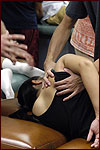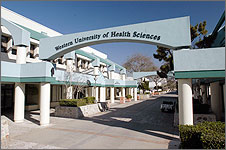New Beginnings for D.O.s in California


Interviews
Demise and new beginnings for D.O.s in CaliforniaIn 1962, the historic event occurred that COP&S which had been thriving since 1914, ceased to exist. D.O.s lost their only educational institution in California. They also lost most of their colleagues in California. There were 400 osteopathic physicians, though, who refused to take the M.D. degree; of these, 250 were members of OPSC which had been established in 1960 to retain the profession in spite of a merger with allopathy. In addition to the loss of their college, their hospitals, clinical training sites and their colleagues, there was also the threat of losing the possibility of licensing new D.O.s in California. In 1962, OPSC had resisted most fervently Proposition 22 which would amend the 1922 Initiative such that the California osteopathic licensing board would lose its power to further license D.O.s. That Initiative had meant the lifeline for the osteopathic profession for 40 years because it had provided legal protection for osteopaths to be an independent, separate, self-controlling and self-disciplining profession with a separate Board of Osteopathic Examiners. OPSC members fought with the few resources they had to educate the public about the implications of the amendment which had been a public decision in 1922. This meant that a new state initiative and a public vote would be needed to reverse the provisions of the 1922 Osteopathic Initiative. When in 1962, this initiative was presented to the California voters, it passed by a significant margin of a 2 1/2 to 1 ratio. The osteopathic profession, it appeared, would soon cease to exist, though there was a potential for hope since Proposition 22 only denied the osteopathic right to license new D.O.s in the state. Most of the remaining osteopathic physicians, meaning those who did not obtain the M.D. degree, still had full scope of practice privileges as the allopathic physicians, as established by law in 1907, under the state’s composite medical licensing board. There were some D.O.s that had a limited scope of practice license, i.e., no drug prescription and no surgery privileges, which was a license category option offered until 1940. Reinstating the licensing power of the Board of Osteopathic ExaminersOPSC persevered through years of frustrating legal battles to reverse the 1962 amendment and to reinstate the power of the state osteopathic licensing board. Though a small group - at times comprising only 35 politically active members, according to Dr. Dilworth - OPSC continued to fight�for the reinstatement of the power of the state osteopathic licensing board to license new D.O.s in�California. OPSC repeatedly took the fight to the state’s legislative and executive branches, to no avail. Then, in 1967, the judicial branch listened to its pleas. Alexander Tobin, a lawyer familiar with civil rights issues, recognized that there was a breech of constitutional granted rights in the part of the Proposition 22 that removed the rights of the licensing board to grant new D.O. licenses. That part restricted the rights of D.O.s from out-of-state wishing to practice in California. Thus, in 1974,�without further opposition and by a unanimous vote, the California State Supreme Court of seven justices reinstated the osteopathic licensing board by ruling that the restrictions imposed upon the California osteopathic licensing board in the initiative act known as Proposition 22 was indeed a restriction of trade, illegal and unconstitutional. Some of the historical documents, including the arguments made to regain licensure, temporarily went to the OPSC office. They are now housed in the archives of the Harriet K. & Philip Pumerantz Library at Western University, College of Osteopathic Medicine of the Pacific, in Pomona, California. With the authority of the Board of Osteopathic Examiners returned, the newly named Osteopathic Medical Board of California (OMBC) has since then been empowered to regulate the osteopathic profession in California. Establishing new osteopathic colleges in CaliforniaSince COP&S had been converted to CCM as part of the merger and then transferred to UC Irvine to become their College of Medicine, a new osteopathic school had to be developed. In 1977 the establishment of the College of Osteopathic Medicine of the Pacific (COMP) in Pomona was celebrated as the profession’s rise from the ashes. The founding Board of Directors of the College of Osteopathic Medicine of the Pacific were Chairman Ethan Allen, D. O., Richard Eby, D.O., Donald Dilworth, D.O., Frank York Lee, M.D. (ex-D.O.), Frank Carr, Vice President of the United California Bank in Pomona, Saul Burnat, Executive Director of the New Mexico Osteopathic Medical Association. Saul Burnat became the second Chairman of the Board from 1978 to 1982, when he died just as the first students were graduating. Since most former faculty members had left the osteopathic profession to become M.D.s, conceiving a new osteopathic faculty became a major challenge. Dr. Pumerantz, the founding president of COMP, recalls that several of the faculty members from the former COP&S helped with the teaching load in the first several months of 1977. Dr. Frymann commuted long distances between her practice in La Jolla and the new College in Pomona. D.O.s from out-of-state came to join the faculty as well. Since then, over 2,500 osteopathic medical students have graduated from COMP and 64% of COMP alumni practice in California. They go into every specialty in medicine. The year 2007 marked the 30th anniversary of the founding of COMP, which is now one of the many professional education colleges at Western University of Health Sciences in Pomona, California. COMP started in a rented office; 30 years later, it is spreading over a significant portion of the 20 acres belonging to Western University. Northern California now also has an osteopathic college, namely Touro University College of Osteopathic Medicine of California (TUCOM). This college matriculated its first class of 66 students in August 1997. Seemingly then, all is well with osteopathy in California, practicing side-by-side with allopathic medicine in a mutually respectful relationship. As described in the book “The Merger: M.D.s and D.O.s in California”, many factors contribute to strengthen this confidence, while causes for concerns are raised as well about the survival of a minority medical profession in an allopathically oriented culture of healthcare in California and nationwide. |